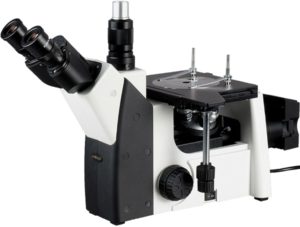Inverted vs Upright Microscope: Which to Choose?
Last Updated on

In this article, we will highlight the individual strengths of inverted and upright microscopes. We will also evaluate their weaknesses, and finally, compare them side by side in the hopes of helping you decide which is right for your purposes.
Read on for a guide on how to choose between an inverted and upright microscope!
What is an Inverted Microscope?
Inverted microscopes are distinct because they use both the light source and the condensing lens directly above the subject that’s being evaluated. Most inverted microscopes are designed specifically for two purposes.
Biological Inverted Microscopes
The biological inverted microscope is used to examine cell behavior. The positioning of the cells beneath the eyepiece of an inverted microscope gives the specimen more room to move around than other microscopes do. There are a variety of easy-to-use biological microscopes geared toward children and students.

Metallurgical Inverted Microscopes
There are also inverted metallurgical microscopes. These are used to examine solid organisms that cannot have light passing through them. They differ from the upright microscope in size. Inverted metallurgical microscopes are able to examine larger subjects.

Inverted microscopes are prized because they can evaluate specimens quickly, and without the same space restrictions that upright units suffer from.
However, to the layperson, there are issues to consider. Chief among them, perhaps, is price. Inverted microscopes are generally more expensive than upright ones, making them better suited for the formal lab setting.
- Can examine large objects
- Quick evaluations
- Space-saving
- Powerful
- Expensive
- Best results in laboratory settings
The Upright Microscope

The upright microscope is what comes to mind for most people when they picture scientific viewing equipment. This is likely the same style of instrument that you used in your elementary school science lab.
The upright microscope has you looking down at the specimen from above. The light source and staging elements are placed beneath the slide specimen.
These are great for taking a peek at fixed subjects, but they also have their limitations. For instance, with upright microscopes, there is always the risk of contaminating the substance you’re looking at with the lens. This is often called “crashing the subject,” and it can happen even to experienced professionals.
Upright microscopes tend to be slower and more tedious than inverted units. They certainly work in a pinch, but there is just a larger margin for error with this instrument.
- Great for fixed subjects
- Super easy to use
- Wide range of options available
- Risk of contaminating the subject
- Slower, larger margin of error
- Rather large and bulky
RELATED READING: An overview of the different types of microscopes
Inverted vs Upright Microscope – Which is Right For You?
Taking this information into consideration, the answer to that question may seem obvious. The inverted microscope is definitely the way to go, right?
It’s not quite that simple.
Performance & Practical Applications
It is true that inverted microscopes outperform upright units in several key ways. However, it’s also true that upright microscopes have been highly effective instruments of scientific study for hundreds of years.
To dismiss them outright is not a good idea. It’s better instead to consider what you’ll be needing the microscope for. If you’re doing high-volume lab work on specimens that need a little more staging room, the inverted microscope has most of the advantages.
Price
However, if you’re shopping on a budget, or just looking for a more casual, hobbyist microscope, an upright might be perfect for your needs. Upright microscopes have long been considered an excellent way to experiment and learn with these tools.

History
Uprights also happen to have been the means through which many important scientific discoveries have come to light. Upright microscopes have been around since (roughly) the year 1600. Inverted microscopes are a product of the late 19th century.
There are reasons that the upright tool has lasted as long as it has. There are also reasons it didn’t go away when the inverted style hit the scene nearly two hundred years ago. They are both highly effective scientific instruments that can do incredible things in the right hands.
Here are some of our other popular microscope posts:
About the Author Robert Sparks
Robert’s obsession with all things optical started early in life, when his optician father would bring home prototypes for Robert to play with. Nowadays, Robert is dedicated to helping others find the right optics for their needs. His hobbies include astronomy, astrophysics, and model building. Originally from Newark, NJ, he resides in Santa Fe, New Mexico, where the nighttime skies are filled with glittering stars.
Related Articles:
How to Clean a Refractor Telescope: Step-by-Step Guide
How to Clean a Telescope Eyepiece: Step-by-Step Guide
How to Clean a Rifle Scope: 8 Expert Tips
Monocular vs Telescope: Differences Explained (With Pictures)
What Is a Monocular Used For? 8 Common Functions
How to Clean a Telescope Mirror: 8 Expert Tips
Brightfield vs Phase Contrast Microscopy: The Differences Explained
SkyCamHD Drone Review: Pros, Cons, FAQ, & Verdict
